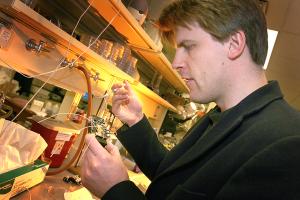Researchers from the University of Illinois at Urbana-Champaign have developed fuel cells that can operate without a solid membrane that separates the fuel from the other materials, and they can also be based on alkaline and not just acids.
Avi Blizovsky and Beni Ran

Pictured: Paul Kenis and the system he developed
Researchers from the University of Illinois at Urbana-Champaign have developed fuel cells that can operate without a solid membrane that separates the fuel from the other materials, and they can also be based on alkaline and not just acids.
Similar to batteries, chemical energy is converted into electrical energy in fuel cells. However, while in most fuel cells a physical barrier is used to separate the fuel from the materials that donate electrons, in the fuel cells developed in Illinois the separation is done through multilayer stratification. "The system is based on a microfluidic channel shaped like the letter Y in which the currents of the fuel and the additional material merge between the electrodes that are covered with a catalytic material without mixing with each other," says Paul Kenis, professor of chemistry and biomolecular engineering and researcher at the Beckman Institute for Advanced Science and Technology.
When the liquids flow through the microscopic channels, they behave differently than when they flow through large pipes, such as those in the domestic sewer pipes - explains Kenis. "There is no mixing on a microscopic scale, and the stratification allows the two currents to be able to pass each other side by side without the need for physical buffering."
The fuel cell consists of two electrodes (anode and cathode), a fuel source and additional material. As a result of the chemical reaction at the anode, protons and electrons are released from the hydrogen atoms. The protons pass through the cell to the cathode, where they return and merge with the electrons that pass through the external circuit. In most fuel cells, an electrolytic polymer membrane is used to separate the cathode from the anode. However, in the fuel cell developed in Illinois, the stratified flow eliminates the need for a physical membrane, and electrons meet protons when the two fluids touch each other.
This configuration has many advantages over conventional fuel cells - among them the few components and the simpler design. In addition to this, the fuel cells can also be based on alkaline. Just as the performance of normal alkaline batteries exceeds that of acid batteries, so the performance of fuel cells based on alkaline is better than that of fuel cells based on acid. "Since our fuel cells do not have a membrane, they do not suffer from the problems that have so far prevented the production of fuel cells based on alkaline" says Kenis.
For news in Science Daily
